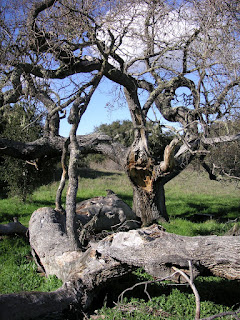

I never noticed the proliferation of strawberries at Jacks Peak before. It helps that these bright white flowers caught my eyes. I certainly have never seen the fruit there. I don't know if they get eaten by animals, collected by humans considering it's a popular public park, or rarely produce fruit since it's so shady.
As I was looking for more information, just to learn something new since I've never bothered to look up strawberries before, I was surprised to find there's a second Calflora site out there. The one I use most often, highly recommend, and link to in most of my plant scientific names is
Calflora.org. The second one is
Calflora.net, which is the
personal site of Michael L. Charter and is based out of Southern California. Other than being a little irritated at the similarity of names, (don't know which came first as they both started in 2005), I'm highly impressed by Michael's elaborate website. Can you imagine the time it took him to create that sucker?!?
So, this got me wondering this morning (posted 02/17/11)... what the heck am I doing with this blog? And, why? It started out innocent enough as a casual "I want to learn about the things I see on my hikes." Now, first thing almost every morning (well, after a bathroom visit and a huge cup of tea), while my husband gets his beauty rest, I quietly work on Nature ID. Plus, with any free pockets of time, I'll update or add more posts, many of them backdated far enough that most followers won't even see them. I'll admit to being a bit obsessive. I'm already at 413 labels and 583 posts and I have yet to reach my 2 year blog anniversary (in May). The label lists along the right side of this blog are becoming unwieldy and extraordinarily lengthy (all that scrolling is probably why my wireless mouse eats through so many batteries). At a certain point, I imagine Google's Blogger will complain with site crashes or start charging for hosting. I don't know where this is going or how I want my blog to be in another year. I watch as several other bloggers stop adding new posts or close their accounts entirely and I suspect they simply got burned out - I still really miss Steve Wilson's Blue Jay Barrens blog. However, I do know what I do not want. I do not want to sell anything and am very proud that this is an ad-free blog. And, I do not want to "network" or show off my abysmal nature knowledge - in other words, there's something really freeing in not being the expert and being totally comfortable in saying, "I don't know." I'm relatively anti-social, hence why I like hiking to get away from people and into nature. I'm not on facebook anymore and generally refuse to join nature groups, clubs, and societies. Although, I have met some very nice people online with similar interests. My questions about the future of Nature ID remain unanswered for now.
With that said, I'd love to hear from fellow bloggers on why you blog.

 acorn woodpecker
acorn woodpecker














































